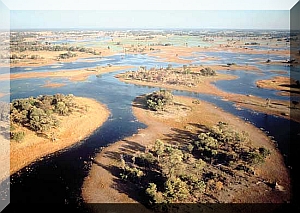Scientific Studies Aid Planning for Okavango River Basin

 |
| Okavango river |
The Permanent Okavango River Basin Water Commission (OKACOM)’s EPSMO Project, which has been gathering information about water flow, plants, animals and human activities in the river basin for the past two years, will finalize its Transboundary Diagnostic Analysis report in May this year, providing essential data to support decision making by the three countries.
The Okavango
OKACOM designed the EPSMO Project to evaluate the condition of the river basin, to identify possible threats posed by increasing demands on the river’s benefits and to develop a program of policy, legal and institutional reforms – a Strategic Action Plan – to meet and manage these demands. The first step was the Transboundary Diagnostic Analysis (TDA).
Based on sound scientific analysis and expert opinion, the TDA aimed to anticipate environmental, social and economic impacts and the requisite policy and institutional challenges of flow regime change due to water resources developments in the basin such as abstractions, impoundments, land use change or climate change.
A multidisciplinary team of scientists from the University of Botswana HOORC, the Polytechnic of Namibia,
OKACOM’s Commissioners will now be able to use these scenarios to identify opportunities and concrete projects and programs needed to balance the needs of conservation and development.
In early February, OKACOM will discuss implications of the study’s findings in a special panel session at the University of Botswana’s Flood Pulsed Wetlands International Symposium at the Harry Oppenheimer Okavango Research Centre in
The Permanent Okavango River Basin Water Commission is an intergovernmental body set up in 1994 by the three countries sharing the basin. OKACOM’s mandate is to ensure equitable use and wise management of the river basin’s benefits. OKACOM’s Secretariat is currently hosted in Maun by the Government of Botswana.
By Monica Morrison
Monica monica@okacom.org is a Communications and Information Specialist, at the OKACOM Secretariat, Maun, Botswana.
